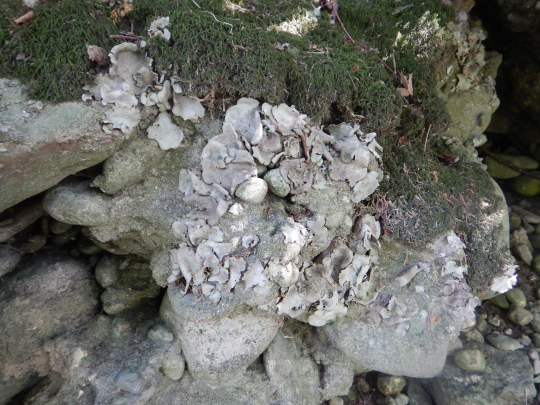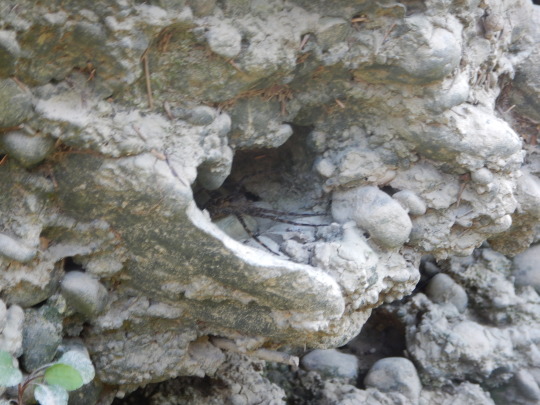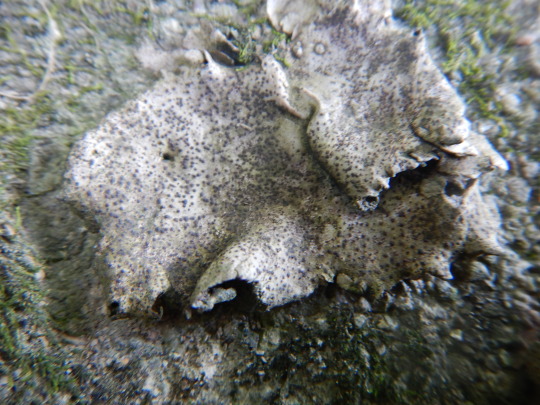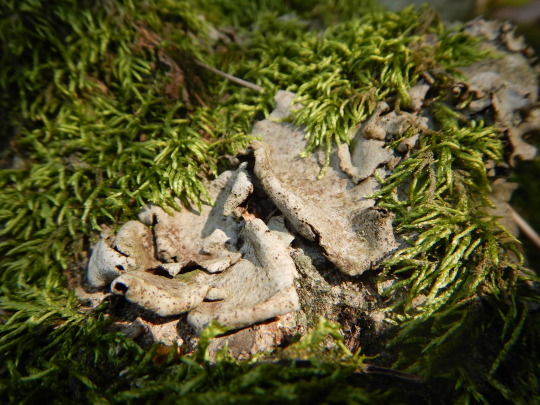#Dermatocarpon
Explore tagged Tumblr posts
Text







Mudstone conglomerate Pt1 Little Miami River
Thalictrum dioicum, Toxicodendron radicans, Sedum ternatum, Dolomedes albineus, and a very large amount of Dermatocarpon muhlenbergii.
I fully expect all of these plants/ spider/ and lichen to be common on rock features like this since it's perfect stable rocky habitat that experiences fairly wet conditions seasonally or rather gets sprayed occasionally, The level of disturbance is some what high in many cases but is variable with each one of these species. Poison ivy for example favors dryness and so does the early meadow rue growing with it but occasional removal of shade species near it is beneficial, Ide say the woodland stone crop prefers similar habit, and is most likely caused by missing these three species some how but flooding around them. The fishing spider cavity was actually near the high water mark on that rock and the rock was littered with them, this was just the only one with it's legs exposed. As for Muhlenberg's stipple back it loves spray and seasonally submerged systems of stable rocky habitat, where as sandstone stippleback/brook is a semi submerged obligate that needs near constant spraying and the white stipple back needs dry rocky habit only.
#ohio#ecology#thalictrum#thalictrum dioicum#toxicodendron radicans#toxicodendron#dermatocarpon#dermatocarpon muhlenbergii#dolomedes#dolomedes albineus#sedum ternatum#sedum#conglomerate
71 notes
·
View notes
Text







Dermatocarpon miniatum
Common stippleback lichen
Ok this lichen is confusing as hell because sometimes it looks like this:


and then sometimes it looks like this:

and then sometimes it looks like this:

Like, what the hell, man? What are you?
Be like D. miniatum--defy description.
images: source | source | source | source
#lichen#lichens#lichenology#lichenologist#lichenized fungus#fungus#fungi#mycology#ecology#biology#botany#bryology#symbiosis#symbiotic organisms#algae#trypo#trypophobia#Dermatocarpon miniatum#Dermatocarpon#I'm lichen it#lichen a day#daily lichen post#I love lichens#lichen subscribe
38 notes
·
View notes
Video
Dermatocarpon cf. bachmannii by Richard Droker Via Flickr: need to look further McCune, Bruce, and Geiser, Linda (2009) Macrolichens of the Pacific Northwest - “Dermatocarpon bachmannii is close to D. deminuens Vainio and molecular analysis indicates that the two taxa are possibly conspecific: specimens from PNW may belong to a third, undescribed species.” spores seem right also - on ultramafic rock (not usually inundated) Fidalgo Island, WA my lichen photos arranged by genus - www.flickr.com/photos/29750062@N06/collections/7215762439... my photos arranged by subject - www.flickr.com/photos/29750062@N06/collections
3 notes
·
View notes
Text
RESULTADOS
Líquenes Foliosos
Se extienden sobre el sustrato, fijándose a él mediante un conjunto de ricinas, Xanthoria o Physcia, o por un solo punto Umbilicaria y Dermatocarpon.
Observacion a simple vista de un liquen folioso

Corte transversal de un liquen folioso donde se observa la composición de sus capas con córtex superior, capa algal ,hifos, córtex inferior y psicoides.

observación de liquen folioso bajo el estereoscopio

detalle de liquen folioso , donde se observa el córtex superior, de forma laminar con la capa inferior diferenciada. Están parcialmente adheridos al sustrato, se pueden separar de él sin destruirlos. Captan el agua tanto del sustrato como de la atmósfera. Existen dos tipos: lobulados (forma prolongaciones en forma de lóbulo y con órganos apendiculares en casi toda la capa inferior, Lobaria) y umbilicados (el talo se adhiere por un ombligo, Lasalia).

detalle de corte transversal de liquen folioso donde se observa sus capas.

Líquenes Gelatinosos
Adquieren una textura cuando menos flexible y pulposa al encontrarse húmedos. En este estado pueden llegar a ser traslúcidos. (Este tipo de líquenes es muy parecido al liquen escamoso).
liquen gelatinoso a simple vista.

liquen bajo el estereoscopio

liquen gelatinoso bajo el microscopio bajo el objetivo 10 x

detalle liquen gelatinoso

Líquenes Fruticulosos
Unidos al sustrato por una superficie de fijación reducida y con forma de pequeños arbustos. Pueden ser cilíndricos, Usnea y Alectoria, o laciniados, Evernia, Ramalina y Cetraria(distintas formas).
liquen filamentoso a simple vista.

observacion de liquen filamentoso bajo el esteroscopio


observación de un corte transversal de un liquen fruticuloso, tienen forma de pequeño arbusto. Se fijan al sustrato mediante un disco de fijación (lóbulos alargados y estrechos que se sujetan al sustrato por la mínima superficie). Sobresalen mucho del sustrato y pueden ser erectos o colgantes. Dependen de la humedad relativa del aire para su hidratación.

detalle de liquen fruticulos baso el microscopio en objetivo 10 x

LIQUEN DIMÓRFICO
Talo compuesto de dos partes diferentes: una fruticulosa y otra crustácea o Escamulosa.

liquen dimórfico bajo el estereoscopio


detalle de lique dimorfico

LÍQUENES CRUSTÁCEOS
CRUSTÁCEOS
Los llamados talos crustáceos son aquellos que crecen fuertemente unidos al sustrato, hasta el punto de que es imposible separarlos de él sin destruirlo. Las características del talo de este tipo de líquenes les permiten sobrevivir en ambientes muy extremos y en superficies expuestas de roca. Poseen organización tanto homómera como heterómera sobre todo en los márgenes de aquellos que posean areolas grandes o en especies intermedias con los líquenes foliosos. No poseen corteza inferior; su crecimiento es marginal pudiendo muchas veces solaparse diversos individuos y formar características estructuras a parches.
En este caso se puede observar al liquen crustaceo de color rojo

liquen crustáceo visto bajo el estereoscopio

detalle lique crustáceo

0 notes
Text
Liking lichen: 3 reasons why the Northern varieties are awesome
Liking lichen: 3 reasons why the Northern varieties are awesome
Want to go on an amazing wildlife safari right here in the Northwest Territories? Bet you’re thinking polar bears, wolverines and caribou, right? I’m talking about creatures much tougher than a polar bear, far cuter than a baby caribou and more enigmatic than a wolverine (yes, I’m prone to hyperbole). I’m talking about lichens.
A fairy puke lichen (Icmadophila ericetorum), like many of these…
View On WordPress
9 notes
·
View notes
Photo






Dermatocarpon arenosaxi
Hey. Do you think this lichen is . . . saxi?
It grows on rocks, so yes it is.
images: source | source
#lichen#lichens#lichenology#lichenologist#lichenized fungus#fungus#fungi#mycology#ecology#biology#botany#bryology#systematics#taxonomy#Dermatocarpon arenosaxi#Dermatocarpon#trypo#Trypophobia#I'm lichen it#lichen a day#daily lichen post#natural science#environmental science#life science#nature#naturalist
43 notes
·
View notes
Photo






Dermatocarpon atrogranulosum
Charred stippleback lichen, Dermatocarpe brûlé
This lichen is rare--like really rare. It has only been found in a handful of locations in British Columbia, Canada, where it grows on limestone outcrops. And that’s all I got. A real mystery, is D. atrogranulosum. I can respect that it likes its privacy, so I won’t blast it more than I already am. Keep on keeping on, little pal.
images: source
info: source
#lichen#lichens#lichenology#lichenologist#lichenized fungus#fungus#fungi#mycology#ecology#biology#Dermatocarpon atrogranulosum#Dermatocarpon
55 notes
·
View notes
Photo




Dermatocarpon miniatum
, silverskin umbrella lichen/ silverskin false rock tripe
Common on all exposed substrate, browns when fully dry, grey green when hydrated(this color).
Photographed: BCC SNP, KY, and the bottom is from Buzzard Roost Rock, Edge Of Appalachia TNC preserve system, Adams Co. Ohio.
1 note
·
View note
Photo


Dermatocarpon miniatum
Adams co. OHIO
0 notes
Photo



Dermatocarpon miniatum
4 notes
·
View notes
Photo









Dermatocarpon intestiniforme
Quilted stippleback lichen
Do I love this name? Do I have it? I can’t decide. But I will say I don’t think D. intestiniforme looks that much like intestines. It mostly looks like a crumpled pile of wet dish rags, but I guess that isn’t easily transcribed into a discreet Latin name? IDK, if I ever name a lichen, I am giving it a cuter epithet. Anyway, this foliose lichen is made up of crumpled, crowded, overlapping lobes attached to the substrate by multiple holdfasts. The upper surface is pruinose (covered in a pale, dusty film) and gray-brown, gray-green, or just straight up pale gray in color, and dotted in numerous black perithecia. The lower surface is pale brown and can be lightly veined. Like many Dermatocarpon lichens, D. intestiformes is pretty rare, and restricted to exposed, calcareous, sloping rocks in montane and arctic-alpine areas. Be careful out there when searching for it, and make sure you aren’t actually looking at a) a small pile of wet rags, or b) a small pile of intestines.
images: source | source
info: source | source | source
#lichen#lichens#lichenology#lichenologist#lichenized fungus#fungus#fungi#mycology#ecology#biology#botany#bryology#systematics#taxonomy#life science#environmental science#natural science#nature#naturalist#beautiful nature#weird nature#the natural world#Dermatocarpon intestiniforme#Dermatocarpon#I'm lichen it#lichen a day#daily lichen post#lichen subscribe#go outside#take a hike
181 notes
·
View notes
Photo






Dermatocarpon leptophyllodes
Jigsaw stippleback lichen
images: source | source
40 notes
·
View notes
Photo









Dermatocarpon americanum
American stippleback lichen
images: source | source | source
31 notes
·
View notes
Photo










Dermatocarpon muhlenbergii
images: source | source | source
27 notes
·
View notes
Photo








Dermatocarpon meiophyllizum
Lumpy, bumpy, and a bit funky (?), D. meiophyllizum is out there growing on streamside rocks, looking like little freckled clay castoffs. It grows in rounded, single-lobed blobs attached to the rock surface by a single holdfast. The upper surface comes in various shades of brown to gray, and the lower surface is typically darker brown to black. But when moist, it becomes more green sue to the presence of its green algal photobiont! The pore-like structures on the surface (perithecia) produce spores which allow the lichen to reproduce. D. meiophyllizum has been documented in Europe and North America, where it is restricted to high elevation streams and creeks.
images: source | source
info: source | source
#cw: trypophobia#trypo#trypophobia#tw: trypophobia#lichen#lichens#lichenology#lichenologist#lichenized fungus#fungus#fungi#mycology#ecology#biology#botany#bryology#biodiversity#life science#natural science#environmental science#nature#naturalist#beautiful nature#weird nature#the natural world#Dermatocarpon#Dermatocarpon meiophullizum#I'm lichen it#daily lichen post#lichen a day
33 notes
·
View notes
Photo





from Kentucky barrens, underappreciated for lichens in my opinion.
-
Yay a mess of unusual alkaline barren lichen, ground dwelling jelly lichens are difficult, so I intend to focus on just the green species seen. With this said; ecologically, each one is a sediment stabilizer on mineral soils. Specifically calcaric sediments in this case. I’ve never been so frustrated at identification when it comes to jelly, though im always excited to see them. I was looking for dolomite stipple back lichen which is different than partially submerged water dolomite stipple back like Dermatocarpon muhlenbergii. these lichens above are not frequently submerged but do enjoy moisture...exposed to air but not often enough to where it won’t fully dry out.
We can see a battle going on where moss and one cool easy identified species being overtaken by a Collema spp. or a Leptogium spp. I checked a karsty check list from the mammoth cave area on lichenportal and boy howdy none of my Collema spp. or Leptogium spp. look like a match so im not sure if I can help.
The green species that looks like a Dermatocarpon spp. is actually Placidium arboreum, which usually grows at the base of trees and looks like a liverwort in that kind of habitat.
4 notes
·
View notes
